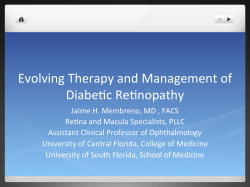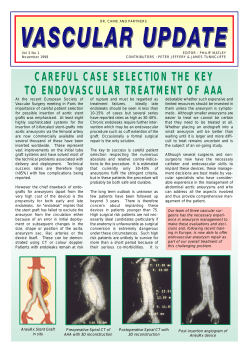
Management of Peripheral Vascular Patients at Duke Hospital: An opportunity to SAVE
Management of Peripheral Vascular Patients at Duke Hospital: An opportunity to SAVE Manesh R. Patel, MD Assistant Professor of Medicine Duke University Medical Center Disclosures Advisory Board Genzyme Interventional Cardiologist Use of “Off-Label” Devices for PAD Outline of Talk Vascular Disease Risk Quality Metrics vs. Performance Measures: what’s the difference? Quality Metric for the vascular center Question # 1 If you had a family member admitted to Duke Hospital for vascular disease problem (i.e. AAA or post SFA revascularization), how would you measure the quality of the care? Clinical Cases Case # 1 Case # 2 50 year old female with DM, HTN, and Tob use 68 year old male with Tobacco Use, HTN and AAA Sees PCP with calf pain Referred for vascular evaluation PCP does ultrasound measure AAA 5.6 cm Referred to Duke Case 1 – 50 y/o Female DM, HTN, and Tobacco use Calf pain with exertion – not clear rest relief No prior CAD history / No back pain Should PAD be suspected / If so why and how should it be evaluated Current Care of Vascular Patients Defining a Population “At Risk” for Lower Extremity PAD Age less than 50 years with diabetes, and one additional risk factor (e.g., smoking, dyslipidemia, hypertension, or hyperhomocysteinemia) Age 50 to 69 years and history of smoking or diabetes Age 70 years and older Leg symptoms with exertion (suggestive of claudication) or ischemic rest pain Abnormal lower extremity pulse examination Known atherosclerotic coronary, carotid, or renal artery disease Slides from ACC/AHA PAD Guideline site – www.acc.org Diagnosis of Peripheral Arterial Disease in High-Risk Patients • PARTNERS evaluated 6979 patients in physicians’ offices • Possibility of PAD evaluated in – All patients 70 yr; mean (±SD) age: 70 (±10 yr) – Patients 5069 yr with history of diabetes and/or smoking (at least 10 pack/yr) Only 49% of PAD patients physicians knew they had PAD 44% 29% 56% Hirsch AT et al. JAMA. 2001;286:1317 Patients diagnosed with PAD PAD only PAD and cardiovascular disease Risk Factors for Peripheral Arterial Disease Reduced Increased Smoking Diabetes Hypertension Hypercholesterolemia Hyperhomocystinemia Fibrinogen CRP Alcohol Relative Risk 0.5 1 2 3 4 Dormandy JA, Rutherford RB, for the TASC Working Group. J Vasc Surg. 2000;31(1 pt 2):S1; Graham IM et al.JAMA. 1997;277:1775; Hiatt WR et al. Circulation. 1995;91:1472; Newman AB et al. Circulation. 1993;88:837; Ridker PM et al. Circulation. 1998;97:425 5 6 Atherothrombotic Diseases in US – The “Big 3” Prevalence (millions) Incidence (millions) Coronary heart disease 13.2 1.2 Cerebrovascular disease 4.8 0.7 Peripheral arterial disease 8.0–12.0 — AHA. Heart Disease and Stroke Statistics—2004 Update. Dallas, Tex.; 2003 10-yr Risk* of Atherothrombotic Events in Patients With Vascular Disease Patient population Increased risk of MI* Increased risk of stroke* PAD 4 (includes only fatal MI and other CHD death) 2–3 (includes TIA) 5–7 (includes death) 3–4 (includes TIA) 2–3 (includes angina and sudden death) 9 greater risk MI Stroke *Compared with general population Adult Treatment Panel II. Circulation. 1994;89:1333 Criqui MH et al. N Engl J Med. 1992;326:381 Kannel WB. J Cardiovasc Risk. 1994;1:333 Wilterdink JL, Easton JD. Arch Neurol. 1992;49:857 Hemodynamic Noninvasive Tests Resting Ankle-Brachial Index (ABI) Exercise ABI Segmental pressure examination Pulse volume recordings These traditional tests continue to provide a simple, risk-free, and cost-effective approach to establishing the PAD diagnosis as well as to follow PAD status after procedures. Noninvasive Diagnosis Interpretation of ABI >1.30 Noncompressible 0.91-1.30 Normal 0.41-0.90 Mild/moderate PAD ≤0.40 Severe PAD/critical limb ischemia Peripheral Arterial Disease: All-Cause Mortality* Patient Survival (%) 100 Normal Subjects ~40% 10-yr mortality 75 Asymptomatic LV-PAD 50 Symptomatic LV-PAD 25 Severe Symptomatic LV-PAD 0 ~75% 10-yr mortality 0 2 4 6 Time (yr) LV-PAD = large-vessel PAD Criqui MH et al. N Engl J Med. 1992;326:381 8 10 12 *Majority of deaths due to cardiovascular causes Case 1 – 50 y/o Female DM, HTN, and Tobacco use Calf pain with exertion – not clear rest relief R > L Diminished +1 pulses bilaterally Seen in Vascular Clinic ABI = 0.53 Right and 0.68 on left Vascular Ultrasound performed Likely Right SFA occlusion Cardiovascular risk factor modification and tobacco cessation Treatment options for PAD Supervised Exercise Rehabilitation I IIa IIb III A program of supervised exercise training is recommended as an initial treatment modality for patients with intermittent claudication. I IIa IIb III Supervised exercise training should be performed for a minimum of 30 to 45 minutes, in sessions performed at least three times per week for a minimum of 12 weeks. Pharmacotherapy of Claudication I IIa IIb III Cilostazol (100 mg orally two times per day) is indicated as an effective therapy to improve symptoms and increase walking distance in patients with lower extremity PAD and intermittent claudication (in the absence of heart failure). Endovascular Treatment for Claudication I Endovascular procedures are indicated for individuals with a vocational or lifestylelimiting disability due to intermittent claudication when clinical features suggest a reasonable likelihood of symptomatic improvement with endovascular intervention and… Response to exercise or pharmacologic therapy is inadequate, and/or b. there is a very favorable risk-benefit ratio (e.g. focal aortoiliac occlusive disease) Summary of Medical Therapy for PAD RCT – no better than placebo Question # 1 If you had a family member admitted to Duke Hospital for vascular disease problem (i.e. AAA or post SFA revascularization), how would you measure the quality of the care? What would you put in place if you could to ensure quality care? Bigger Rooms Better Food Better equipment Combined vascular service Are there any interventions that reduce clinical events? What is the clinical effect of PAD in North Carolina? Lower Extremity Amputations in North Carolina All Payors, 2006 Alleghany Alleghany Ashe Ashe Surry Surry Watauga Wilkes Watauga Wilkes Avery Avery Caldwell Caldwell Mitchell Mitchell Rockingham Rockingham Person Person Stokes Stokes Caswell Caswell Warren Warren Vance Vance Northampton Northampton Halifax Halifax Granville Granville Alamance Alamance Yadkin Yadkin Franklin Franklin Forsyth Forsyth Guilford Durham Guilford Durham Camden Camden Gates Gates Pasquotank Pasquotank Currituck Currituck Hertford Hertford Perquimans Perquimans Bertie Bertie Chowan Chowan Edgecombe Edgecombe Alexander Alexander Davie Washington Washington Orange Orange Davie Nash Nash Martin Wake Wake Martin Tyrrell Tyrrell Dare Dare Burke Burke Iredell Iredell Davidson Davidson Wilson Wilson Randolph Randolph Chatham McDowell McDowell Chatham Catawba Catawba Rowan Rowan Buncombe Buncombe Pitt Pitt Johnston Haywood Haywood Johnston Hyde Hyde Greene Greene Swain Swain Lincoln Lincoln Beaufort Beaufort Rutherford Rutherford Lee Lee Cabarrus Cabarrus Montgomery Montgomery Harnett Harnett Henderson Henderson Wayne Wayne Cleveland Cleveland Graham Graham Polk Polk Moore Moore Jackson Jackson Gaston Gaston Stanly Stanly Craven Lenoir Lenoir Craven Macon Macon Cumberland Cumberland Pamlico Pamlico Cherokee Cherokee Mecklenburg Mecklenburg Transylvania Transylvania Richmond Richmond Clay Clay Hoke Hoke Jones Jones Union Union Duplin Sampson Sampson Duplin Anson Anson Scotland Scotland Carteret Carteret Yancey MadisonYancey Madison Robeson Robeson Onslow Onslow Bladen Bladen Pender Pender Top 5 NC Counties with the highest rate of amputations per 1,000 people County # Amputations FFY 2006 2007 Population Amputations per 1,000 Gates, NC 15 11,569 1.30 Warren, NC 21 19,018 1.10 Northampton, NC 24 21,767 1.10 Tyrrell, NC 4 3,922 1.02 Franklin, NC 42 53,303 0.79 Columbus Columbus New New Hanover Hanover Brunswick Brunswick NC Counties: Amputations per 1,000 people 1.04 to 1.3 (3) 0.78 to 1.04 (3) 0.52 to 0.78 (20) 0.26 to 0.52 (47) 0 to 0.26 (27) Data Source: Thompson Reuters Note: Amputation defined as procedure codes 84.10, 84.12‐84.18, 84.3 Lower Extremity Amputations MEDPAR, 2006 NorthDakota Dakota North Washington Washington Montana Montana Minnesota Minnesota SouthDakota Dakota South Oregon Oregon Idaho Idaho Maine Maine Wisconsin Wisconsin Vermont Vermont Michigan Michigan Wyoming Wyoming New York York New Nebraska Nebraska Iowa Iowa Indiana Indiana Nevada Nevada Utah Utah Illinois Illinois Colorado Colorado Kansas Kansas Missouri Missouri Kentucky Kentucky Virginia Virginia Tennessee Tennessee NorthCarolina Carolina North California California Oklahoma Oklahoma Arizona Arizona New Hampshire Hampshire New Massachusetts Massachusetts Rhode Island Island Rhode Connecticut Connecticut Pennsylvania Pennsylvania Ohio Ohio New Jersey Jersey New Maryland Maryland Delaware Delaware West Virginia Virginia West WashingtonDC DC Washington Arkansas Arkansas New Mexico Mexico New Alabama Alabama Mississippi Mississippi Texas Texas Nearly 70% of lower extremity amputations (excluding toes) in North Carolina were for patients with Medicare. SouthCarolina Carolina South Georgia Georgia Amputation rates Louisiana Louisiana per 1,000 people age 65+ Florida Florida 3 to 3.75 (1) 2.25 to 3 (1) 1.5 to 2.25 (10) 0.75 to 1.5 (32) 0 to 0.75 (7) Puerto Puerto Ric Ric Note: Amputation defined as procedure codes 84.10, 84.12‐84.18, 84.3 SAVE – Stop Amputations and Vascular Events A proposal Quality Cycle – Structure Process Outcomes Duke CPOE Structure – Standardized Order sets Measure pre and post use Outcomes Quality Metric vs. Performance Measure Quality Metric – Performance Measure Measureable entity that is believed to represent some part of quality of care (process or outcome) – generally not publically reported Daily Weights with CHF vs. A measure that is so grounded in evidence that failure to adhere results in poor patient outcomes (reduced CMR ‘pay for performance’ ASA administration Measure # 1 – Anti-platelet therapy for vascular disease ACC/AHA Class I – Level of Evidence A ASA or Clopidogrel as secondary prevention for patients with CHD Dose – OASIS 7 – 25,000 patients randomized 2 x 2 factorial design in press NEJM – ASA 81 mg vs. 325 similar efficacy with mild increase in bleeding with 325 mg Admission order set for all vascular patients includes ASA 81 mg as a default Recommendation – Post-Endovascular Therapy order set for all patients includes ASA 81 mg and Plavix 75 mg Proposal Measure # 2 – Statin Therapy Fluvastatin and Perioperative Events in Patients Undergoing Vascular Surgery Olaf Schouten, Eric Boersma, Sanne E Hoeks, Robbert Benner, et al. The New England Journal of Medicine. Boston: Sep 3, 2009. Vol. 361, Iss. 10; pg. 980 Background Adverse cardiac events are common after vascular surgery. We hypothesized that perioperative statin therapy would improve postoperative outcomes. Methods In this double-blind, placebo-controlled trial, we randomly assigned patients who had not previously been treated with a statin to receive, in addition to a beta-blocker, either 80 mg of extended-release fluvastatin or placebo once daily before undergoing vascular surgery. Lipid, interleukin-6, and C-reactive protein levels were measured at the time of randomization and before surgery. The primary end point was the occurrence of myocardial ischemia, defined as transient electrocardiographic abnormalities, release of troponin T, or both, within 30 days after surgery. The secondary end point was the composite of death from cardiovascular causes and myocardial infarction. Statins with vascular surgery Results A total of 250 patients were assigned to fluvastatin, and 247 to placebo, a median of 37 days before vascular surgery. Levels of total cholesterol, lowdensity lipoprotein cholesterol, interleukin-6, and Creactive protein were significantly decreased in the fluvastatin group but were unchanged in the placebo group. Postoperative myocardial ischemia occurred in 27 patients (10.8%) in the fluvastatin group and in 47 (19.0%) in the placebo group (hazard ratio, 0.55; 95% confidence interval [CI], 0.34 to 0.88; P=0.01). Death from cardiovascular causes or myocardial infarction occurred in 12 patients (4.8%) in the fluvastatin group and 25 patients (10.1%) in the placebo group (hazard ratio, 0.47; 95% CI, 0.24 to 0.94; P=0.03). Fluvastatin therapy was not associated with a significant increase in the rate of adverse events. Statin Therapy in Vascular Surgery Conclusions In patients undergoing vascular surgery, perioperative fluvastatin therapy was associated with an improvement in postoperative cardiac outcome. Recommendations Beta-blocker therapy around the time of surgery – reduce events and AF Recommendations – Beta-Blocker and Statin Bisoprolol 2.5 – 5 mg fixed dose (low) Fluvastatin XR 80 mg Duke version – Toprol XL 50-100 mg Duke Favored – Simvastatin 20 mg Post – procedure Groin Care? Arteriotomy Closure Device – AHA Scientific Statement (in press) Arteriotomy closure devices should not routinely be utilized to reduce vascular complications in patients undergoing invasive cardiovascular procedures via the femoral artery approach (Class III – Level of Evidence B). Post closure or pull – need standard evaluation and nursing checks Proposal Pre Endovascular Procedure Order Set ASA 81 mg Plavix 75 mg Simvastatin 20 mg ½ NS with Sodium Bicarbonate Admission Vascular Service Orders ASA 81 mg Bisoprolol 2.5 mg (or home B-blocker) Simvastatin 20 mg (or home statin) Smoking Cessation Counseling – Nurses to provide Clinical Cases Case # 1 Case # 2 50 year old female with DM, HTN, and Tob use 68 year old male with Tobacco Use, HTN and AAA Sees PCP with calf pain Referred for vascular evaluation PCP does ultrasound measure AAA 5.6 cm Referred to Duke Lower Extremity Amputations in North Carolina All Payors, 2006 Alleghany Alleghany Ashe Ashe Surry Surry Watauga Wilkes Watauga Wilkes Avery Avery Caldwell Caldwell Mitchell Mitchell Rockingham Rockingham Person Person Stokes Stokes Caswell Caswell Warren Warren Vance Vance Northampton Northampton Halifax Halifax Granville Granville Alamance Alamance Yadkin Yadkin Franklin Franklin Forsyth Forsyth Guilford Durham Guilford Durham Camden Camden Gates Gates Pasquotank Pasquotank Currituck Currituck Hertford Hertford Perquimans Perquimans Bertie Bertie Chowan Chowan Edgecombe Edgecombe Alexander Alexander Davie Washington Washington Orange Orange Davie Nash Nash Martin Wake Wake Martin Tyrrell Tyrrell Dare Dare Burke Burke Iredell Iredell Davidson Davidson Wilson Wilson Randolph Randolph Chatham McDowell McDowell Chatham Catawba Catawba Rowan Rowan Buncombe Buncombe Pitt Pitt Johnston Haywood Haywood Johnston Hyde Hyde Greene Greene Swain Swain Lincoln Lincoln Beaufort Beaufort Rutherford Rutherford Lee Lee Cabarrus Cabarrus Montgomery Montgomery Harnett Harnett Henderson Henderson Wayne Wayne Cleveland Cleveland Graham Graham Polk Polk Moore Moore Jackson Jackson Gaston Gaston Stanly Stanly Craven Lenoir Lenoir Craven Macon Macon Cumberland Cumberland Pamlico Pamlico Cherokee Cherokee Mecklenburg Mecklenburg Transylvania Transylvania Richmond Richmond Clay Clay Hoke Hoke Jones Jones Union Union Duplin Sampson Sampson Duplin Anson Anson Scotland Scotland Carteret Carteret Yancey MadisonYancey Madison Robeson Robeson Onslow Onslow Bladen Bladen Pender Pender Top 5 NC Counties with the highest rate of amputations per 1,000 people County # Amputations Amputations per FFY 2006 2007 Population 1,000 Gates, NC 15 11,569 1.30 Warren, NC 21 19,018 1.10 Northampton, NC 24 21,767 1.10 Tyrrell, NC 4 3,922 1.02 Franklin, NC 42 53,303 0.79 Columbus Columbus New New Hanover Hanover Brunswick Brunswick NC Counties: Amputations per 1,000 people 1.04 to 1.3 (3) 0.78 to 1.04 (3) 0.52 to 0.78 (20) 0.26 to 0.52 (47) 0 to 0.26 (27) Data Source: Thompson Reuters Note: Amputation defined as procedure codes 84.10, 84.12‐84.18, 84.3 Case 1 – 50 y/o Female DM, HTN, and Tobacco use Case 1 Angiogram Case 1 – 50 y/o Female DM, HTN, and Tobacco use Innovation – Lower Extremity PAD Approach - Endo vs. Surgical Device PTA Cryotherapy Stent “Biliary” Stents Fracture Risk DES-Lower Ext. Atherectomy Directional / Orbital Laser Invasive Angio Room – Immediate Multi-angle view 90-CLI - Angiogram Clinical Significance of PAD 10 million in US, 5-15% >50 years No gender bias 50% symptomatic; 2.5 million undiagnosed Disease severity directly related to CV event rate Critical limb ischemia → 25% annual mortality Same CV death risk as those with established CAD, regardless of symptom status Shared cardiac risk factor profile implies similar treatment strategies Collaborative Research Amputation Rates North Carolina / USA PAD database – all patients with PAD in cath lab Location Angiographic Stenosis Radiation Exposure during cases PAD – Gene Clinical Outcomes Thank You Popular Mechanics, 1954 ADA Consensus Statement: PAD in People With Diabetes Due to the high estimated prevalence of PAD in patients with diabetes —A screening ABI should be performed in patients >50 yr who have diabetes If normal, test should be repeated every 5 yr — Screening ABI should be considered in diabetic patients <50 yr who have other atherothrombotic risk factors Smoking Hypertension ADA. Diabetes Care. 2003;26:3333 • • Hyperlipidemia Duration of diabetes >10 yr
© Copyright 2025





















